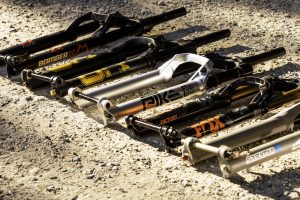No one can accuse Santa Cruz of jumping on the XC bandwagon; along with the V10, the original Santa Cruz Blur helped pioneer its VPP suspension.
Santa Cruz Blur XC CC X01 AXS RSV review
Even before the original Santa Cruz Blur – even before VPP in fact – the single-pivot Santa Cruz Superlight was a firm favourite among XC racers and trail riders alike. It’s fitting then, that the latest Blur XC blends aspects of the old and new world. The Superlight single-pivot suspension design is back, albeit with flexstays and a linkage-actuated shock to deliver 100mm travel.
Combined with Santa Cruz’s modern carbon tech, it’s the lightest Blur the brand has ever produced. How light? Well, compared to the previous Blur, Santa Cruz has managed to whittle away 289g from the frame weight alone, which helps explain why our size large test bike weighed an impressive 10.45kg (22.95lb), which is lighter than most of the best crosscountry mountain bikes we’ve encountered.
With 100mm of rear travel in pure XC guise – there’s also a longer-travel TR option – it’s no surprise that Santa Cruz dropped its signature twin-link suspension for a lighter flexstay design. It’s pretty much ubiquitous on the XC circuit, because everyone has worked out that replacing bearings, links and pivot hardware with flex in the carbon stays is a great way to save substantial amounts of weight.
But that’s not the only change to the suspension on the Blur XC. Santa Cruz also adopted a flatter leverage rate so it could rely less on anti-squat to stop the suspension bobbing – claiming that this approach allows the suspension to have more traction and sensitivity both climbing and descending. We actually dropped the shock out of the bike and it’s interesting that there’s no noticeable spring force in the flexstays until you get deeper in the travel, which could explain why we struggled to use all of the 100mm available travel.
Geometry-wise, the Blur is modern, if not quite progressive, with a 68° head angle and 463mm reach. The fit is spot on and thanks to the size-specific geometry that sees the chainstay length increase by 2.5mm with every jump in frame size, the Blur feels remarkably well balanced and that weight distribution should translate to all four frame sizes.

RockShox SIDLuxe with 100mm of travel and simple rebound adjustment
Suspension
We’ve already mentioned how the suspension design on the Blur has evolved, so let’s take a closer look at the suspension components. The 100mm-travel SID SL Ultimate fork has slender 32mm upper tubes, and everything about it has been optimised for weight saving – even the rebound adjuster and valve cap on the air spring have been stripped to the bare bones. Santa Cruz adds in some rigidity to the SID SL by taking full advantage of the fork’s Torque Cap compatibility. An added bonus being that oversized hub end-caps make it much easier to locate the hub and axle in the dropouts when fitting the front wheel.
Matching travel on the rear is provided by a RockShox SIDLuxe Ultimate shock. Just like the SID fork, adjustments are limited to air pressure and rebound, and like the fork, sag gradients make setting up the suspension a breeze.

Twistlock toggles suspension on and off while freeing up bar space
The fork and shock are both hardwired to the SRAM Twistlock remote. Ring its neck to choke the suspension for a firmer pedaling response, then simply press the button on the collar of the twist grip to resuscitate the suspension. It’s fast and easy to use, and because it leaves plenty of space for the dropper post remote, you never get confused as to which lever to press. It also gives the Blur two very distinct suspension modes.

34t SRAM X1 chainset with chain guide
Components
In keeping with the lightweight theme, the Blur XC uses a standard 31.8mm bar and stem. The Santa Cruz carbon XC bar has a great profile and at 760mm it’s wide enough for even the broadest of XC brawlers. And while the black alloy stem looks positively dull next to, say, Scott’s carbon one-piece construction, the forged Syntace unit is optimised for stiffness and reduced weight. Santa Cruz has definitely focused on weight saving here, but it hasn’t been at the expense of comfort as the WTB Silverado saddle and silicone ESI grips both do a great job at isolating the rider from high- frequency vibrations, which is somewhat indicative of the Blur’s overall focus on longer multi-stage races, rather than sprint XCO events.
Launched in conjunction with the new Blur, the Reserve 28 XC carbon rims have a shallow profile and 28mm internal width, making them ideal for the higher- volume 2.4in Maxxis Aspen tyres. And at 385g per rim they make the Blur XC effortless to accelerate.

How does the Santa Cruz Blur ride?
Santa Cruz Blur performance
Given its impressive weight, we were half-expecting the Santa Cruz Blur XC to ride like a wet noodle. It was anything but. Proof, if it were needed, that you don’t have to oversize everything to achieve a precise, accurate ride. Granted, the overall package is not as stiff as a Scott Spark, both in terms of frame stiffness and suspension response, but on the descents that actually played to the Blur’s advantage. By offering a smoother, more composed ride with increased traction, it often felt like we were running the tyres harder on the Spark, even though the pressures were identical on both bikes.

Hunkering down on the Blur
The reach numbers on both bikes are also identical, but the Santa Cruz feels more open in the cockpit and that’s because the ultra-short head tube on the Scott gives it an artificially long reach measurement. So even though the Santa Cruz is steeper and has a shorter wheelbase, it still feels really stable.
In fact, it’s only when you start to climb that Santa Cruz loses ground. The more open and active suspension response, that otherwise makes it a joy to ride, sinks into its travel with every turn of the crank. It’s as if the suspension needs more support at sag, and less end-stroke progression. You need to be prepared to constantly switch between the two suspension settings to maximize efficiency. The fact that the rear suspension bobs when just spinning lightly along the road may be enough to put some hardcore XC riders off. But for multi-day or marathon-style racing, the extra comfort and control that the Blur offers may well outweigh any loss in pedalling efficiency.

Santa Cruz Blur
Verdict
This is no average XC race bike. Yes, the Blur XC is light, only has 100mm travel and all of the components have been selected with durability and compatibility in mind. Stand up to sprint and it’s tight and reactive. Bomb down the descents and it’s remarkably composed. Spin along the flatout or grind up a climb however and the rear suspension is, how do we put this, overly active. So unless you use the remote lockout, the Blur XC feels slightly laboured on the climbs. It’s the bike’s only shortcoming. But in XC racing you can’t afford to show any weakness.
















